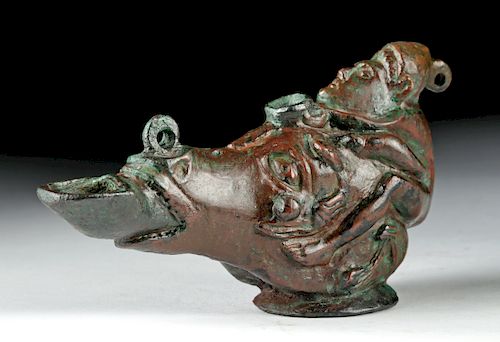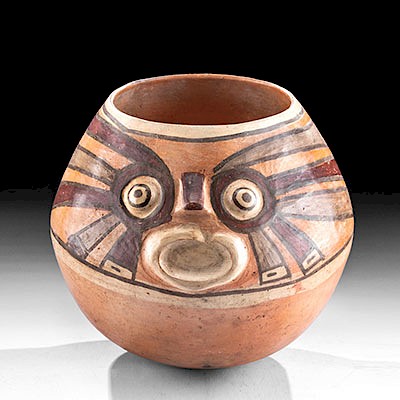Roman Bronze Oil Lamp - Erotic Satyr on Horse Head
Lot 27a
About Seller
Artemis Gallery
686 S Taylor Ave, Ste 106
Louisville, CO 80027
United States
Selling antiquities, ancient and ethnographic art online since 1993, Artemis Gallery specializes in Classical Antiquities (Egyptian, Greek, Roman, Near Eastern), Asian, Pre-Columbian, African / Tribal / Oceanographic art. Our extensive inventory includes pottery, stone, metal, wood, glass and textil...Read more
Categories
Estimate:
$12,000 - $16,000
Absentee vs Live bid
Two ways to bid:
- Leave a max absentee bid and the platform will bid on your behalf up to your maximum bid during the live auction.
- Bid live during the auction and your bids will be submitted real-time to the auctioneer.
Bid Increments
| Price | Bid Increment |
|---|---|
| $0 | $25 |
| $300 | $50 |
| $1,000 | $100 |
| $2,000 | $250 |
| $5,000 | $500 |
| $10,000 | $1,000 |
| $20,000 | $2,500 |
| $50,000 | $5,000 |
| $100,000 | $10,000 |
| $200,000 | $20,000 |
About Auction
By Artemis Gallery
Dec 5, 2019
Set Reminder
2019-12-05 10:00:00
2019-12-05 10:00:00
America/New_York
Bidsquare
Bidsquare : Ancient / Ethnographic - Holiday Edition
https://www.bidsquare.com/auctions/artemis-gallery/ancient-ethnographic---holiday-edition-4710
What to give this holiday season? Ancient & Ethnographic Art of course! Our special Holiday auction features hundreds of unique finds from all over the world. Artemis Gallery info@artemisgallery.com
What to give this holiday season? Ancient & Ethnographic Art of course! Our special Holiday auction features hundreds of unique finds from all over the world. Artemis Gallery info@artemisgallery.com
- Lot Description
Roman, Egypt, ca. 2nd century BCE. A very heavy bronze oil lamp of a generally pear shape depicting a humanized Satyr riding a horse in a somewhat erotic fashion. The lamp has a flared foot and suspension loops - one above the horse's snout and one behind the satyr's head. Finely delineated with details in relief and incised - the half-nozzle upturned with a raised flange. A striking example, replete with impressive form and iconography - as well as a gorgeous patina that has developed over the ages. Size: 5.25" L x 3" H (13.3 cm x 7.6 cm)
In earlier Greek art, Silenos appear as grotesque, old, and ugly; however, in later art, especially in Attic works, these characteristics were softened to present a more youthful and graceful aspect. We witness this humanization or transformation of the Satyr in late Greek art. The depiction on this example may be modeled upon this humanized depiction. Another example of this shift occurs in the portrayal of Medusa and in that of the Amazon, characters who are traditionally depicted as barbaric and uncivilized. A humanized Satyr is also depicted in a work of Praxiteles known as the "Resting Satyr".
Provenance: private Florida, USA collection, purchased in 1999 from Avraham Rosen, New York, New York, USA. Consignor had the piece vetted by Christie's New York in 2013 - estimate was $6,000 - $8,000.
All items legal to buy/sell under U.S. Statute covering cultural patrimony Code 2600, CHAPTER 14, and are guaranteed to be as described or your money back.
A Certificate of Authenticity will accompany all winning bids.
We ship worldwide and handle all shipping in-house for your convenience.
#146416Minor nicks to periphery of base. A tiny casting flaw atop the horse's snout and on the satyr's back. Otherwise intact and excellent. Gorgeous green and rich brown patina.Condition
- Shipping Info
-
All shipping is handled in-house for your convenience. Your invoice from Artemis Gallery will include shipping calculation instructions. If in doubt, please inquire BEFORE bidding for estimated shipping costs for individual items.
-
- Buyer's Premium



 EUR
EUR CAD
CAD AUD
AUD GBP
GBP MXN
MXN HKD
HKD CNY
CNY MYR
MYR SEK
SEK SGD
SGD CHF
CHF THB
THB
















